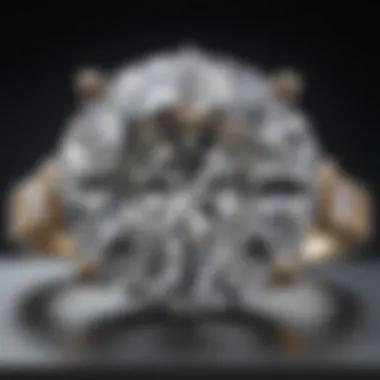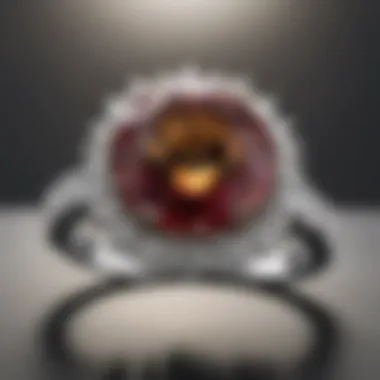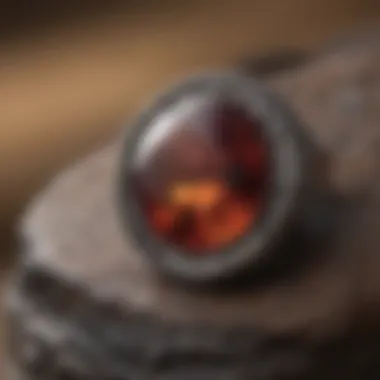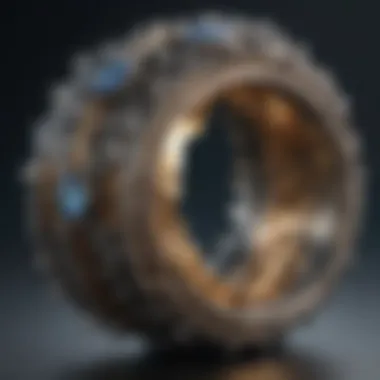Exploring Different Prong Settings in Jewelry Design


Intro
When it comes to jewelry design, particularly in the realm of engagement and decorative rings, the importance of prong settings can't be overstated. They anchor gemstones firmly, allowing them to catch light just right, which brings out their beauty. However, not all prong settings are created equal, and understanding the nuances can greatly enhance your jewelry experience. This exploration delves into the various types of prong settings, their aesthetic qualities, and practical implications.
The right choice between traditional and modern prong settings not only affects how a piece looks but also its durability and maintenance. Let’s journey through the different types of prong settings to help both enthusiasts and potential buyers make informed decisions.
Understanding Prong Settings
Understanding prong settings is essential for anyone who wishes to delve into the world of jewelry, especially those involved with engagement rings or decorative pieces. This familiarity not only enhances appreciation for the craftsmanship involved but also informs choices related to both aesthetics and functionality. Prong settings play a pivotal role in securing gemstones, affecting everything from brilliance to everyday practicality.
Assembling the relationship between design and durability, prong settings provide a delicate balance that elevates the visual impact of a piece while ensuring the stone remains protected. Ultimately, this knowledge leads to more informed decisions, enabling gemstone enthusiasts and collectors to select settings that align with their style, lifestyle, and budget.
Definition of Prong Settings
A prong setting is a type of jewelry setting that holds a gemstone in place using metal claws or prongs. These prongs are often used in various designs, such as rings, necklaces, and earrings, gripping the edges of a stone to secure it. While the standard number is four prongs, variations can include two, three, or even more, depending on the designer's intention and the overall design aesthetic.
The unique aspect of prong settings lies in their ability to showcase a gemstone’s beauty. By elevating the stone, they allow light to enter from multiple angles, enhancing dazzling reflections and maximizing brilliance. They also provide an unobstructed view of the gemstone, which is especially desirable for larger or more valuable stones.
Historical Background
The history of prong settings goes back centuries, and it's fascinating to see how they've evolved. In ancient times, jewelry was often crafted with simple techniques, prioritizing functionality over beauty. The Egyptians, for instance, were known to use more wrapped techniques to create ornamental pieces of adornment.
As time progressed, from the Renaissance onward, the aesthetics of jewelry construction gained significance. Prong settings began to emerge as a favored choice, allowing for more intricate designs while offering practicality. Notably, during the Victorian era, heavier settings with more elaborate designs became popular, while the Art Deco movement introduced cleaner lines with springy and geometric patterns.
Today, the craft of prong settings can be seen in both contemporary and vintage jewelry. These settings continue to reflect the evolving tastes of society, merging timeless elegance with modern innovations.
Types of Prong Settings
When diving into the world of jewelry, the type of prong setting you choose can make or break your design. Prong settings are not just functional; they imbue each piece with personality and charm. The importance of detailing these types lies not only in their aesthetics but also in the practical considerations that can dictate the longevity and integrity of your jewelry. From engagement rings to fashion pieces, understanding the nuances can guide choices that cater to both style and functionality.
Single Prong Setting
Characteristics
The single prong setting is as minimalist as they come. This style uses a solitary prong to secure a gemstone, allowing for a striking view of the stone itself. The standout characteristic here is the visibility—this open design makes it a popular choice to showcase particularly stunning or unique gems. However, it’s worth noting that while many find it appealing for its simplicity, it does raise some risks related to stability.
Optimal Gemstone Use
This setting is most suitable for smaller stones or those with unique cuts, like trillion or marquise, where the gem's shape can shine without obstruction. The single prong effectively holds the stone without overshadowing it, lending itself to an elegant appearance. Though, larger or heavier stones may not be ideal as they could tip the scales—literally and figuratively.
Advantages and Disadvantages
The advantage of a single prong setting is clear; it provides a clean, unobstructed view of the stone, which can be captivating. On the downside, there's a trade-off. The single prong offers less security, making it potentially risky for stones that might be subject to impact or snagging. Careful consideration is essential; this option tends to lean toward the aesthetic rather than the pragmatic.
Four-Prong Setting
Design Overview
Popular across the board, the four-prong setting is a balance between security and showcase. Visually, it brings a sense of structure to the piece, often epitomizing classic elegance in rings. Each prong holds the gemstone at crucial points, providing an effective balance that maintains the gem’s position without crowding it.
Stability and Security


The four-prong setting checks the stability box, securing a stone while allowing enough light to pass through. This balance means minimized risk of loosening over time, making it a solid choice for everyday wear. One key feature is that it allows for an adequate hold without being overwhelming; the prongs become an integral rather than an obstructive element of design.
Common Applications
Typically found in engagement rings, the four-prong setting caters to a variety of stone shapes like round brilliant cuts. Many jewelers lean towards this design for its versatility and enduring appeal. It's a well-known go-to as it blends functionality with aesthetics, making it a popular pick for many occasions.
Six-Prong Setting
Comparison to Four-Prong
While the four-prong is great, the six-prong setting escalates the level of security. This design incorporates additional prongs, increasing the overall holding power. It is especially beneficial for larger stones by distributing the weight more evenly. The enhanced security ensures that precious gems remain snugly in place, which can alleviate concerns for the wearers who engage in active lifestyles.
Benefits of Increased Coverage
With six prongs, there's a greater surface area in contact with the stone, which translates to superior support. The more extensive coverage adds extra peace of mind, particularly when it comes to preserving the integrity of more expensive or rarer gems. It’s a small but significant change that amplifies the durability of jewelry.
Ideal Stone Shapes
This setting is ideal for round stones, where the prongs can be positioned symmetrically. However, it can hold other shapes, providing a sense of security without sacrificing the stone’s beauty. It's important to consider the stone's characteristics as certain cuts may shine even more prominently under this configuration.
Crown Setting
Overview of Crown Setting
The crown setting resembles exactly what you might imagine—a crown! This setting typically elevates a gemstone above its band with intricate prong work that mimics a crown's embellishment. This unique setting brings a regal flair that can be ideal for statement pieces.
Perceived Elegance
One definitive characteristic of the crown setting is its ability to project an image of opulence. The raised design draws the eye upward, giving stones a lofty presentation that many collectors find attractive. For those seeking a distinguished look, incorporating this type offers an effective way to elevate a standard piece into something extraordinary.
Best Practices for Use
To truly maximize the crown setting's charm, choose gemstones that complement the height and visual impact of the design. Regular maintenance is key, given that the elevation can expose the stone to wear. A careful approach during use can help ensure its long-term appeal while maintaining that enviable sparkle.
V-Prong Setting
Unique Design Elements
The V-prong setting showcases unique design features that offer both stylistic flair and remarkable support. With prongs that taper into a sharp point, this setting often accentuates the shape of the gemstone while providing a stable grip. It stands out for its ability to cradle and highlight the stone while maintaining a minimalist silhouette.
Light Reflection Qualities
A distinct aspect of the V-prong design is how it interacts with light. The prongs create an almost gallery-like effect that enhances the diamond’s brilliance, reflecting even more light than traditional shapes. This quality makes it an attractive option especially for stones that are cut to maximize their shine.
Ideal for Specific Cuts
This type is particularly well-suited for pear-shaped diamonds, where the tapered prongs enhance the stone’s natural form. It can also work wonders for marquise cuts, further emphasizing their elongated elegance. Choosing the right stone shape is essential to ensuring this setting accomplishes its visual objectives.
Illusion Setting
Unique Aesthetic Appeal


The illusion setting is known for its ability to create the appearance of a larger stone by employing smaller diamonds or gemstones around a central piece. This unique design glosses over the need for a large singular gem, providing brilliance and glam without breaking the bank.
Interactions with Surrounding Stones
What sets the illusion setting apart is how surrounding stones can shift perceptions, playing off one another to enhance the central gem. This beautifully orchestrated interaction can create a captivating visual dynamic that delights those who gaze upon it.
Practical Considerations
However, with beauty comes certain practical considerations. The use of multiple stones means that proper care is essential to avoid any potential wear or loosening. The intricate nature of the design requires regular inspection and potential updates to maintain its stunning appearance.
Choosing the Right Prong Setting
Selecting the right prong setting is crucial in the realm of jewelry design, especially for engagement rings and other significant pieces. The choice of prong setting can significantly affect the overall aesthetics of the jewelry as well as the security of the stones used. Understanding the nuances of each type of prong setting helps potential buyers avoid common pitfalls and enhance the allure of their chosen pieces.
Factors to Consider
Stone Type and Shape
When considering a prong setting, the type and shape of the stone play a vital role. Certain gemstones, such as diamonds, are often cut into specific shapes like round, princess, or marquise, which influences the choice of the setting. Round shapes generally fit well with four-prong and six-prong settings, providing ample support and allowing light to enter uniformly. Increasing light reflection may enhance the stone's brilliance, making it a popular choice among buyers.
However, some shapes, like an emerald cut, might better suit a four-prong or even a bezel setting due to their long angles and facets. This setting reduces the visibility of the prongs, allowing the stone to be the main attraction. The unique characteristic here is that the setting should complement the shape, ensuring both security and aesthetics are maintained. If a prong is not well-suited for the chosen shape, it may detract from the beauty of the stone.
Personal Style and Preference
Personal taste adds another layer of complexity when choosing prong settings. Each individual has a unique style, whether it's vintage, modern, or minimalist. Selecting a setting that reflects one’s personal style can elevate the appeal of the jewel. For instance, a sleek, modern setting may enhance the contemporary look of a simple solitaire diamond ring, while a vintage-inspired design may suit someone who cherishes elegance from bygone eras.
This aspect is instrumental as it personalizes the jewelry, making it resonate more with the wearer. An effective selection not only enhances aesthetics but also ensures that the wearer feels a connection to the piece. However, one must also be cautious; a chosen style that is too trendy may not stand the test of time, potentially diminishing the long-term satisfaction.
Usage Context
Perhaps one of the most practical considerations when selecting a prong setting is how and where the jewelry will be worn. For everyday wear, a secure setting with minimal protrusion is advisable, as it is less likely to snag on clothing or hit against hard surfaces, which can lead to damage. On the other hand, for special occasions, a more elaborate setting featuring additional stones and ornate design may be suitable.
Understanding the context of usage can greatly influence the durability of the piece. A high-set prong with significant elevation may look stunning for special events but could pose risks for daily activities. Buyers must balance visual appeal with practicality, ensuring that their choice fits seamlessly into their lifestyle without causing inconvenience.
Budget Considerations
Impact of Settings on Pricing
The choice of prong setting also directly affects pricing. Intricate designs or higher numbers of prongs often lead to an increase in labor costs. For example, a six-prong setting will typically command a higher price than a simple four-prong one due to the extra metal required and the craftsmanship involved in securing the stone securely.
Moreover, materials used in the setting can also influence the budget significantly. High-quality metals like platinum will be pricier than more commonly used metals like sterling silver or gold. It's essential to weigh the importance of the setting's visual appeal against its cost, ensuring it fits within the overall budget while still achieving the desired look and security.
Long-Term Value
Investment in a good quality prong setting can have long-term benefits. A well-crafted setting contributes to the longevity of a piece, protecting the stone effectively over the years. This not only maintains the value of the gemstone but also ensures that the piece can be passed down through generations without showing significant wear and tear.
On the flip side, selecting a low-quality setting may ultimately lead to more expenses in repairs or replacements, detracting from the initial cost-effectiveness. Buyers should bear in mind that investing in a quality prong setting can save money and maintain the aesthetic integrity of the jewelry in the long run.
Trade-Offs
Choosing the right prong setting often comes with trade-offs. For instance, while a higher number of prongs can enhance stability, they may also block light from entering the stone, potentially dulling its brilliance. Conversely, fewer prongs may allow more light in but increase the risk of the stone being dislodged.


Additionally, the aesthetic appeal of various settings can lead to tough decisions. Stylish settings with complex designs may catch the eye, but they could be impractical for day-to-day wear. Hence, it's critical to balance aesthetics with functionality, understanding that each choice represents a compromise between visual appeal, practical safety, and budget constraints.
"When it comes to jewelry, it’s not just about beauty; understanding the practical aspects of settings can preserve that beauty for years to come."
Overall, selecting the right prong setting requires careful consideration of various factors, ensuring that every aspect from stone shape to personal style aligns with the wearer's preferences and practical needs.
Maintaining Prong Settings
Proper maintenance of prong settings plays a pivotal role in preserving both the beauty and integrity of your jewelry. Over time, wear and environmental factors can jeopardize the security of gemstones, leading to potential loss or damage. Considering the investment often involved in acquiring such pieces, understanding maintenance strategies ensures that your jewelry remains not just an accessory but an enduring legacy.
Regular Inspection
Signs of Wear
As beautiful as prong settings are, they are not immune to the everyday wear and tear that comes with time. Signs of wear are often subtle yet crucial indicators of a setting's health. One key characteristic to watch for is the presence of looseness in the prongs. If you can wiggle the stone even slightly, that’s a clear red flag. Another indication may be the presence of scratches or dullness on the metal, which can hint that your setting may need a good look-over.
Detecting these signs early can prevent a costly mishap. The unique feature of these signs is that they can sometimes go unnoticed due to their gradual progression. Regular attention to these details can save you from heartache later. Moreover, being proactive means ensuring that your cherished pieces continue to sparkle without the risk of losing a beloved gemstone—making vigilance a wise and popular choice among jewelry enthusiasts.
When to Seek Professional Help
Knowing when to seek professional help can be as important as regular inspection. If you've noticed any concerning signs of wear, or if your jewelry just feels off, this is a good time to consult an expert. A key characteristic here is understanding that some damages are simply beyond home repair. Jewelers can offer precision adjustments that maintain the setting’s integrity far better than DIY methods.
In many cases, seeking help early can save you from larger, more expensive repairs down the road. The unique edge of professional intervention lies in their experience and tools, which you likely don’t have at home. Remember, getting an expert's eye can be a beneficial measure for any valuable piece, ensuring longevity without compromising its aesthetic appeal.
Cleaning Techniques
Safe Cleaning Solutions
Cleaning your prong-set jewelry is essential in maintaining its sheen, but it must be done carefully. Safe cleaning solutions, such as gentle soap and warm water, are often best for most settings. You avoid harsh chemicals that could erode the metal or cloud the stone. This characteristic makes using safe options quite beneficial—not just for the jewelry itself, but for the peace of mind it brings to owners.
The unique feature of safe cleaning solutions is their accessibility; you likely already have the items in your home. This makes regular cleaning easy to incorporate into your routine, lessening the chance of neglecting your pieces. Overall, the advantages clearly outweigh the drawbacks, especially when it comes to preserving intricate designs and ensuring that those brilliant stones continue to dazzle.
Methods for Different Stones
Different gemstones may require different cleaning techniques due to their varying properties. For example, diamonds can handle an occasional dip in soapy water, while softer stones like opals or emeralds need a more delicate approach. Understanding these differences can be exceptionally crucial in maintaining your jewelry’s beauty over time.
A key characteristic of these methods is that they cater specifically to the nature of each stone, thereby reducing the risk of damage. The unique aspect is the personalization involved; what works for one gemstone might harm another. Thus, knowing the right method amplifies the longevity of your precious jewels and helps them retain their original allure.
Remember to identify the type of gemstone and research recommended care protocols. Proper maintenance practices not only keep your jewelry looking its best but also ensure it remains a cherished possession for years to come.
End
The importance of the conclusion in this article cannot be overstated. It serves as a critical lens through which readers can reflect on the information presented about prong settings in jewelry design. While the intricacies of each setting type contribute significantly to understanding their functionality and style, the conclusion acts as a summary that crystallizes the key takeaways.
In today's jewelry market, where personal taste and craftsmanship intertwine, knowing which prong setting best suits a specific gemstone and the wearer's lifestyle is essential. This can impact both the durability and the overall aesthetic of the piece. A thoughtfully chosen setting enhances not just the beauty but also the security of the gemstone, ensuring it remains a cherished possession for years to come.
Moreover, the closing reflections offered here highlight the essential considerations one must contemplate: from types and shapes of stones to the budget and maintenance. These points reaffirm the significance of the earlier discussions and encourage jewelry enthusiasts, collectors, and designers alike to approach prong settings with a more discerning eye.
"Choosing the right prong setting can make the difference between a fleeting trend and a timeless classic."
Summary of Key Points
- Different types of prong settings serve unique functions and styles, each highlighting the gem's beauty.
- The discussion on maintaining prong settings underscores ongoing care and regular inspections to prevent wear and tear.
- Understanding the factors influencing choice, such as personal style, gemstone type, and intended use, is crucial for informed decision-making.
- Budget considerations impact the options available without compromising the value of the piece.
Final Thoughts on Prong Settings
In sum, prong settings are not merely about holding a gemstone securely, rather they represent a fusion of art and engineering. Every decision made regarding a prong setting—be it a crown or a V-prong—affects the overall presentation and longevity of the jewelry. As styles and trends evolve, and as one learns more about these settings, the ability to select a prong setting that aligns with individual aesthetics and functional needs will deepen.
Jewelry is an extension of personal identity and taste. Therefore, whether designing a piece from scratch or selecting an existing one, knowledge of prong settings plays a crucial role in ensuring each piece has a lasting impact. Armed with the insights from this article, readers can confidently navigate the realm of jewelry with a greater appreciation for the craftsmanship behind prong settings.



